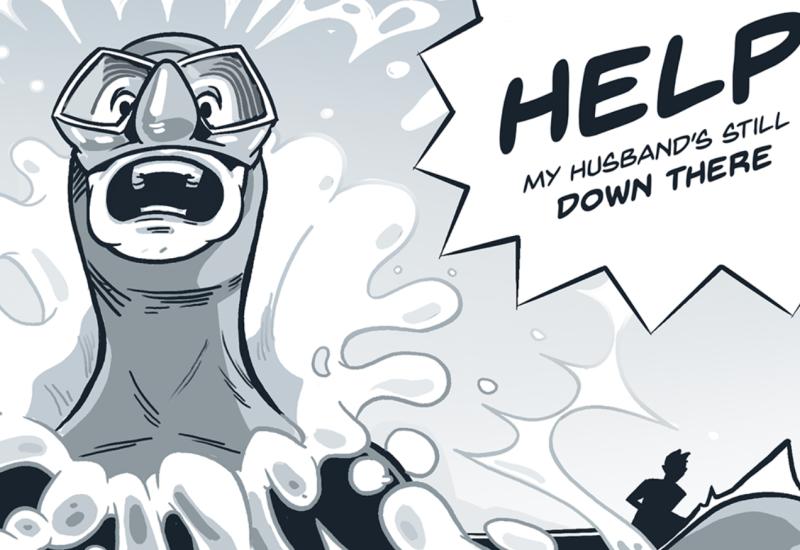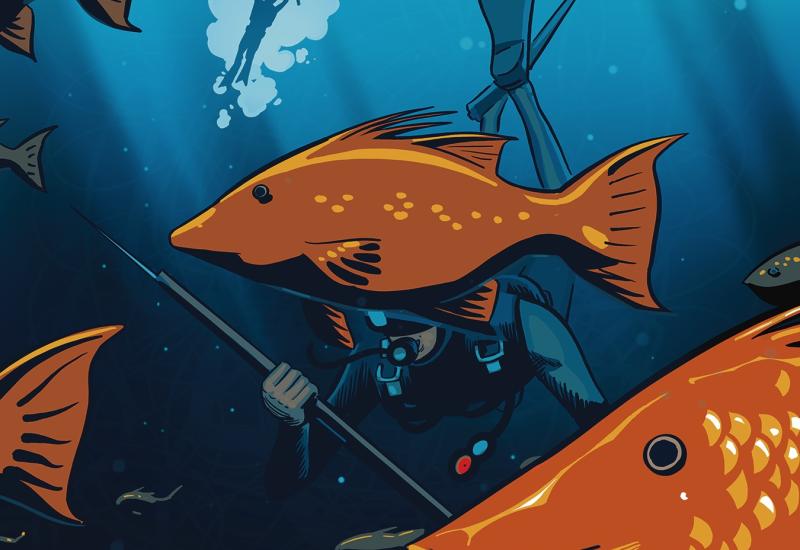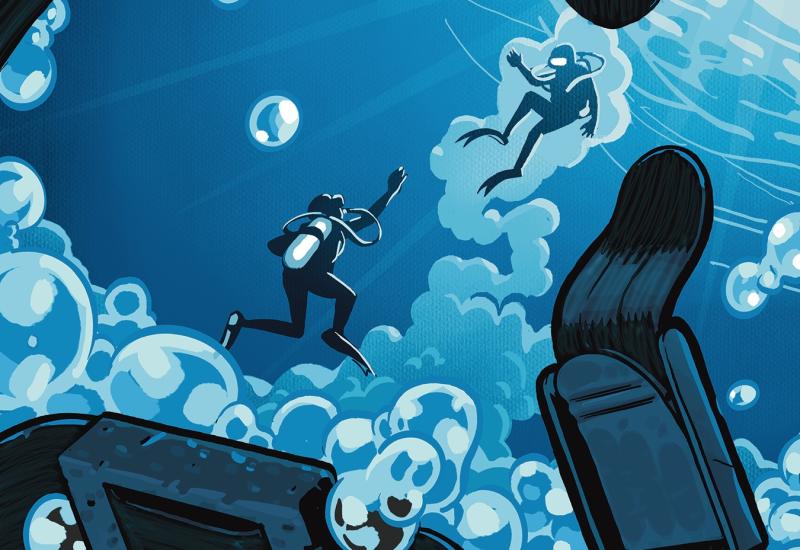Down Drafts: 5 Life-Saving Tips
August 2000
Case 1
Ed.'s note: The incidents described here are real. Names of locations and people have been changed or deleted.
The diving had been great — five days of easy drift diving on a Caribbean island known for its walls. Although Anne dived only on vacation once a year, she had her own gear and had been doing these dive trips for many years. She had never taken any advanced training or a scuba refresher, but she was comfortable diving. It was so easy to just drift and let the dive guides and boat crews deal with all the logistics, planning and details of the diving.
Anne preferred the smaller boats with fewer divers, signing up for her dives directly with local dive operators after she arrived on island. For her last day of diving, she wanted to do something special, so she shopped around for an operator going to a dive site she hadn't been to. A small local operation was offering a trip to a remote reef known for its unique marine life and strong current.
The trip out to the site was easy, although this boat was not as fast or as large as the others she had been on. It also did not carry oxygen or have a radio. The crew and dive guide spoke only limited English, but were friendly and helpful. Anne entered the water with the small group of divers and the guide after a limited briefing.
She was never seen again.
As it turned out, the edge of this reef had a significant downwelling. As the large mass of water, driven by the strong current, reached the edge of the reef, it plunged downward into the abyss.
The dive boat returned to shore without Anne. Not knowing where she was staying, the operator decided to wait until someone asked about her, and therefore made no report that she was missing. Because Anne was single and lived alone, it wasn't until the next week, when she did not return to work, that her family started an investigation, which led from the airline to the hotel to the dive operator.
The family's desire to bring a legal action against the dive operator turned out to be hopeless. The legal system of the country in which the accident happened allowed for little litigation, the few legal actions that were permitted had extremely low monetary limits, and the ability of American attorneys to function in the foreign court was extremely limited.
Case 2
One evening after dinner, a dive instructor's phone rang.
"Hello, this is Fred," the instructor answered.
"Fred, this is Neal. You saved my life, man!"
"Oh, really? How so?"
Neal had taken a weeklong dive trip on a live-aboard in the Pacific. On many of the dives, a small tender from the live-aboard took divers to a site, dropped them off, then picked then up as they surfaced. On one trip, the divers were dropped off near an island with the admonition to stay close to shore. The offshore currents were not only strong, but vortexes were not uncommon in this area, causing the water to swirl in a downward flow, as in a whirlpool.
Due to delays among the other divers, and the crew not being sure of their position, Neal was the last to enter the water. By the time he descended, he was not only no longer with the group, he was also not with his assigned buddy. He almost immediately realized that he was in a very strong current with no bottom in sight. Putting it all together — no group, no buddy, no bottom, strong current — Neal decided to abort the dive and started swimming for the surface. Within moments, he realized that not only was he not moving toward the surface, he was being pulled downward at an accelerating rate.
Fear was rapidly turning to panic as he passed 100 feet, still kicking. Then the voice of his instructor, Fred, started playing inside his head — "If all hope is lost, get positively buoyant." Neal ditched his weights, pushed his power inflator button and continued to kick for the surface. After a few more agonizing moments, he paused at 135 feet, then started up, at first slowly, then faster and faster until he had to dump air from his BC to slow his ascent as he approached the surface.
The crew later apologized for their mistake of dropping divers at the wrong place. Neal suffered no physical injury from his near-miss, but he became much more careful about putting his safety in the hands of others.
Lessons For Life
-
Be aware of what dive guides and boat crews are doing. Do not give the responsibility for your safety to others.
-
Be sure that any boat you dive from has a radio and carries oxygen.
-
Let someone else know your plans and be sure the dive operator takes emergency contact information.
-
If you're unable to deal with a problem under water, get positively buoyant and go to the surface. If possible, slow down or stop on the way up, but remember that it's far better to risk decompression illness and be on the surface breathing, than to be on the bottom not breathing.
August 2000
Case 1
Ed.'s note: The incidents described here are real. Names of locations and people have been changed or deleted.
The diving had been great — five days of easy drift diving on a Caribbean island known for its walls. Although Anne dived only on vacation once a year, she had her own gear and had been doing these dive trips for many years. She had never taken any advanced training or a scuba refresher, but she was comfortable diving. It was so easy to just drift and let the dive guides and boat crews deal with all the logistics, planning and details of the diving.
Anne preferred the smaller boats with fewer divers, signing up for her dives directly with local dive operators after she arrived on island. For her last day of diving, she wanted to do something special, so she shopped around for an operator going to a dive site she hadn't been to. A small local operation was offering a trip to a remote reef known for its unique marine life and strong current.
The trip out to the site was easy, although this boat was not as fast or as large as the others she had been on. It also did not carry oxygen or have a radio. The crew and dive guide spoke only limited English, but were friendly and helpful. Anne entered the water with the small group of divers and the guide after a limited briefing.
She was never seen again.
As it turned out, the edge of this reef had a significant downwelling. As the large mass of water, driven by the strong current, reached the edge of the reef, it plunged downward into the abyss.
The dive boat returned to shore without Anne. Not knowing where she was staying, the operator decided to wait until someone asked about her, and therefore made no report that she was missing. Because Anne was single and lived alone, it wasn't until the next week, when she did not return to work, that her family started an investigation, which led from the airline to the hotel to the dive operator.
The family's desire to bring a legal action against the dive operator turned out to be hopeless. The legal system of the country in which the accident happened allowed for little litigation, the few legal actions that were permitted had extremely low monetary limits, and the ability of American attorneys to function in the foreign court was extremely limited.
Case 2
One evening after dinner, a dive instructor's phone rang.
"Hello, this is Fred," the instructor answered.
"Fred, this is Neal. You saved my life, man!"
"Oh, really? How so?"
Neal had taken a weeklong dive trip on a live-aboard in the Pacific. On many of the dives, a small tender from the live-aboard took divers to a site, dropped them off, then picked then up as they surfaced. On one trip, the divers were dropped off near an island with the admonition to stay close to shore. The offshore currents were not only strong, but vortexes were not uncommon in this area, causing the water to swirl in a downward flow, as in a whirlpool.
Due to delays among the other divers, and the crew not being sure of their position, Neal was the last to enter the water. By the time he descended, he was not only no longer with the group, he was also not with his assigned buddy. He almost immediately realized that he was in a very strong current with no bottom in sight. Putting it all together — no group, no buddy, no bottom, strong current — Neal decided to abort the dive and started swimming for the surface. Within moments, he realized that not only was he not moving toward the surface, he was being pulled downward at an accelerating rate.
Fear was rapidly turning to panic as he passed 100 feet, still kicking. Then the voice of his instructor, Fred, started playing inside his head — "If all hope is lost, get positively buoyant." Neal ditched his weights, pushed his power inflator button and continued to kick for the surface. After a few more agonizing moments, he paused at 135 feet, then started up, at first slowly, then faster and faster until he had to dump air from his BC to slow his ascent as he approached the surface.
The crew later apologized for their mistake of dropping divers at the wrong place. Neal suffered no physical injury from his near-miss, but he became much more careful about putting his safety in the hands of others.
Lessons For Life
Be aware of what dive guides and boat crews are doing. Do not give the responsibility for your safety to others.
Be sure that any boat you dive from has a radio and carries oxygen.
Let someone else know your plans and be sure the dive operator takes emergency contact information.
If you're unable to deal with a problem under water, get positively buoyant and go to the surface. If possible, slow down or stop on the way up, but remember that it's far better to risk decompression illness and be on the surface breathing, than to be on the bottom not breathing.










